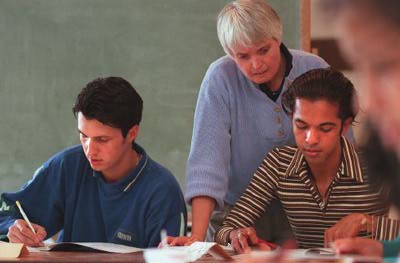
TUTOR
Second-language classes designed
to offer immigrants needed skills
* Some are able to speak English, but not read and write it; others have basic speaking skills.
Published: Tuesday, May 5, 1998
By Tom Beyerlein Dayton Daily News
Sidebar to part 3
Since she became an English-as-a-second-language tutor almost nine years
ago, Char Greene has become "a student of the world."
And why wouldn't she? Her class at St. John's United Church of Christ in
downtown Dayton includes natives of Russia, Bosnia, India, Mexico and
Pakistan.
 JIM WITMER DAYTON DAILY NEWS
JIM WITMER DAYTON DAILY NEWSRed Cross ESL teacher Char Greene works with student Carlos Serrano (right) and Dario Kristic in class. |
There's a shortage of tutors like Greene. "I think it's very necessary for our community," Greene said of the tutoring program.
"The foreigners do so much of our dirty work in society. We have a responsibility to make sure they can function and be part of us and not just our laborers, our slaves."
Montgomery and Greene counties are home to eight free ESL programs, serving about 600 students a year. Three other programs are available for a fee.
Officials say it's impossible to know how many potential ESL students are in the area.
It's common for refugees to come to the area in waves - Vietnamese, Bosnians, Rwandans, Russian Jews - depending on the changing political climate. Some settle here, others eventually relocate.
Local ESL students have varied backgrounds. In the 1996-97 school year, the local Red Cross ESL program had students representing 35 countries and 39 languages, said tutor Eileen Rehg.
Students' needs also vary greatly. Some students have learned to read and write in English in their home countries but lack conversational practice.
Others have been in the U.S. long enough to pick up speaking skills but can't read or write in English.
In either case, their children often learn English before they do.
"My son becomes my teacher," said Berarda Trejo, a 28-year-old ESL student from Mexico.
ESL students often are intelligent and highly motivated, Rehg said.
"I have the highest respect for these people," she said. "Learning another language is very difficult - you're just reduced to a child again."
The alternatives, however, are reduced opportunities in America and being limited to socializing "in their own language enclaves," Rehg said.
Larisa Permyakova, a 35-year-old accountant from Siberia, is engaged to a Daytonian.
She likes it here and plans to spend the rest of her life here, but "I feel no comfortable. His family speaks English and I no understand."
Greene is helping Permyakova to learn English as part of a program sponsored by the Miami Valley Career Technology Center.
Meanwhile, Greene said people like Permyakova have taught her a lot.
"In the military I was ready to kill all these people - the Russians, the Soviets," said Greene, an Air Force retiree. "Now I see they're just people with dreams like all of us. I was a warrior and now I think (of the arms race), what a waste."
Despite the many nationalities of her students, Greene said "we usually can solve most communication problems, but it takes a little time. You just learn to be patient.
"It gives me a lot," she said of her tutoring work. "It's just a real good feeling to know they're functional and I had a little part in helping them get there."
Part 3 sidebars:* teaching basic skills* second language classes * two immigrants' stories * literacy by race * document literacy |
Back to Part 2 Go to Part 4 |